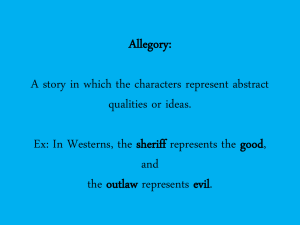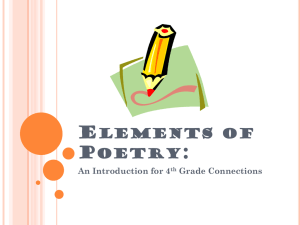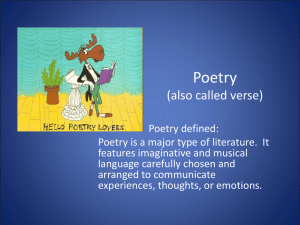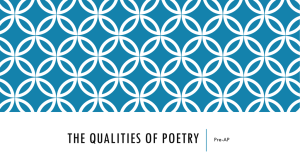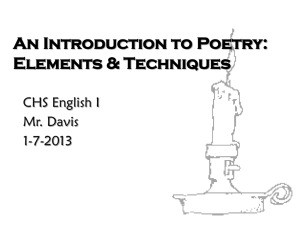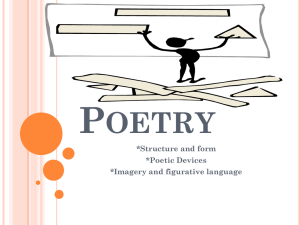Introduction to Poetry
advertisement
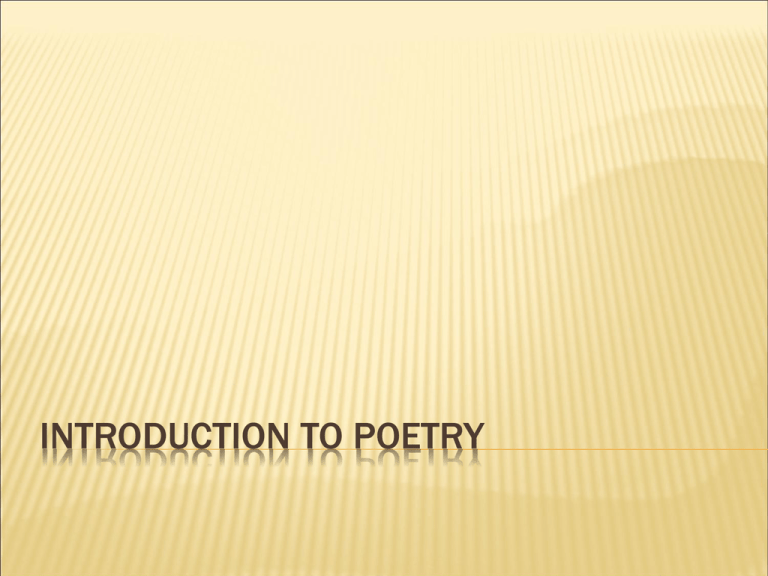
INTRODUCTION TO POETRY WHAT IS POETRY? Poetry is the most misunderstood form of writing. It is also arguably the purest form of writing. Poetry is a sense of the beautiful; characterized by a love of beauty and expressing this through words. It is art. WHAT IS POETRY? CONT. Like art, poetry is very difficult to define because it is an expression of what the poet thinks and feels and may take any form the poet chooses for this expression. Often it takes the form of verse, but not all poetry has this structure. Poetry is a creative use of words which, like all art, is intended to stir an emotion in the audience. CONSTRUCTING POETRY Poetry, though it may seem simple in appearance, is a very complex art form, which is why it can be difficult to construct and deconstruct. When constructing, or even reading poetry, it is important to consider the following: the form or structure, the meter or beat, sound devices, meaning devices, and linguistic devices. STRUCTURE OF POETRY Poetry generally has some structure that separates it from prose. The basic unit of poetry is the line. It serves the same function as the sentence in prose, although most poetry maintains the use of grammar within the structure of the poem. STRUCTURE OF POETRY Most poems have a structure in which each line contains a set amount of syllables; this is called meter. Lines are also often grouped into stanzas. The stanza in poetry is equivalent or equal to the paragraph in prose. STRUCTURE OF POETRY Often the lines in a stanza will have a specific rhyme scheme. Some of the more common stanzas are: Couplet: a two line stanza Triplet: a three line stanza Quatrain: a four line stanza Cinquain: a five line stanza METER Meter is the measured arrangement of words in poetry, the rhythmic pattern of a stanza, determined by the kind and number of lines. This is the “beat” of the poem. Meter is an organized way to arrange stressed/accented syllables and unstressed/unaccented syllables. Whose woods / these are / I think /I know METER CONT. The unit of meter is called the foot. The length of lines is described by the number of repeated "meters" in the line. Meter (1), dimeter (2), trimeter (3), tetrameter (4), pentameter (5), hexameter (6), heptameter (7) and octameter (8). ....1.............. 2.................3..............4................ 5 Shall I | com PARE | thee TO | a SUM | mer’s DAY? The above would be considered a pentameter. STRESS PATTERNS The most common foot in English is the iamb, which consists of two syllables, the second one of which is accented. Another common foot is the trochee (also two syllables, but with the first accented) Some metrical feet (dactyl and anapest) have three syllables. STRESS PATTERNS Iamb Unstressed + Stressed / - / - / / and walked with inward glory crowned 2 Syllables Trochee Stressed + Unstressed / / - / - / Piping down the valleys wild 2 Syllables Anapest Unstressed + Unstressed + Stressed 3 Syllables - / / - - / - - / The Assyrian came down like a wolf on the fold Dactyl Stressed + Unstressed + Unstressed 3 Syllables / / - - / - - / - Woman much missed, how you call to me, call to me. STRESS PATTERNS Spondee Stressed + Stressed / / / - - - / - - / White founts falling in the court of the sun 2 Syllables The spondee is a very important poetic device that poets can use to emphasis meaning within their writing style. Pyrrhic Unstressed + Unstressed 2 Syllables / / - / / When the blood creeps and the nerves prick The pyrrhic is also known as a dibrach. It is unrealistic to construct a whole, serious poem with spondees or pyrrhics - consequently, they mainly occur as variants within other structures. STRESS PATTERNS A line with three iambic feet is known as iambic trimeter. A line with six dactylic feet is known as dactylic hexameter. Shakespeare is famous for his use of the iambic pentameter. / / / / / But soft! What light through yonder window breaks? BLANK VERSE Blank verse: unrhymed iambic pentameter, common in Shakespeare's plays and many longer poems, such as John Milton's Paradise Lost, the beginning of which provides a famous example: Of Man's First Disobedience, and the Fruit Of that Forbidden Tree, whose mortal taste Brought Death into the World, and all our woe, With loss of Eden, till one greater Man Restore us, and regain the blissful Seat, Sing Heav'nly Muse. . . FREE VERSE Free verse is just what it says it is - poetry that is written without proper rules about form, rhyme, rhythm, and meter. In free verse the writer makes his/her own rules. The writer decides how the poem should look, feel, and sound. FREE VERSE EXAMPLE Winter Poem~By Nikki Giovanni once a snowflake fell on my brow and i loved it so much and i kissed it and it was happy and called its cousins and brothers and a web of snow engulfed me then i reached to love them all and i squeezed them and they became a spring rain and i stood perfectly still and was a flower SOUND DEVICES All sound devices are interesting, because they bring together words that sound alike, but do not necessarily have anything else in common. In "Fire and Ice" the two words in the title are opposite in meaning but have the same vowel sound (assonance). The poem, which at times suggests that the two are the same in a much as both can "end" the world, would be much less effective if the words lacked this assonance. This is why poetry is so difficult to translate. FIRE AND ICE Some say the world will end in fire, Some say in ice. From what I've tasted of desire I hold with those who favor fire. But if it had to perish twice, I think I know enough of hate To say that for destruction ice Is also great And would suffice. ~Robert Frost ALLITERATION Alliteration is the repetition of the same sounds or of the same kinds of sounds at the beginning of words or in stressed syllables, as in "on scrolls of silver snowy sentences" (Hart Crane). Modern alliteration is predominantly consonantal. To find an alliteration, you must look the repetitions of the same consonant sound through out a line. ASSONANCE the relatively close succession of the same or similar vowel sounds, but with different consonants: a kind of vowel rhyme. From William Carol Williams' "The Red Wheelbarrow" Glazed with rain water beside the white chickens. CONSONANCE The relatively close succession of the same end consonants with different vowel sounds: a kind of consonant rhyme. Notice all the "r" sounds in the last six lines of "Hyla Brook": Its bed is left a faded paper sheet Of dead leaves stuck together by the heat A brook to none but who remember long. This as it will be seen is other far Than with brooks taken otherwhere in song. We love the things we love for what they are. ONOMATOPOEIA The formation or use of words such as buzz or murmur that imitate the sounds associated with the objects or actions they refer to is called an onomatopoeia. It is a word or a grouping of words that imitates the sound it is describing, such as animal noises like "oink" or "meow", or suggesting its source object (these are the more important ones), such as "boom", "click", "bunk", "clang", "buzz", or "bang". IDENTIFY THE ONOMATOPOEIAS SOUND OF NATURE by Marie Josephine Smith Ticking, tocking. Head is rocking. Tippy toeing. Quietly. Snap, crack. Crushing branch. Helter, skelter. Run for shelter. Pitter, patter. Rain starts to fall. Gathering momentum. Becomes a roar. Thunder booms. RHYME Rhyme is when the endings of the words sound the same. Read the poem and note the rhyming end words. Dust of Snow by Robert Frost The way a crow Shook down on me The dust of snow From a hemlock tree Has given my heart A change of mood And save some part Of a day I had rued. RHYME SCHEME Rhyme scheme is the pattern of rhyming words at the end of each line. Not all poetry has a rhyme scheme. They are not hard to identify, but you must look carefully at which words rhyme and which do not in order to determine the rhyme scheme. RHYME SCHEME Poems of more than one stanza often repeat the same rhyme scheme in each stanza. Dust of Snow by Robert Frost A B A B C D C D The way a crow Shook down on me The dust of snow From a hemlock tree Has given my heart A change of mood And save some part Of a day I had rued. REPETITION Repetition is the repeating of a sound, word, or phrase for emphasis. Inside Inside the house (I get ready) Inside the car (I go to school) Inside the school (I wait for the bell to ring) MEANING DEVICES Diction- Writer’s choice of words The words that a writer chooses to use may carry both denotative and connotative meanings. Denotative- is its explicit definition as listed in a dictionary. Connotative- the association or set of associations that a word usually brings to mind CONNOTATIVE Connotation Evil, danger, deceit VS. DENOTATIVE Denotation any of numerous scaly, legless, sometimes venomous reptiles; having a long, tapering, cylindrical body and found in most tropical and temperate regions FIGURATIVE LANGUAGE Whenever you describe something by comparing it with something else, you are using figurative language. Figurative language is any language that goes beyond the literal meaning of words in order to furnish new effects or fresh insights into an idea or a subject. FIGURATIVE LANGUAGE The most common figures of speech are simile, metaphor, and alliteration. Figurative language is used in poetry to compare two things that are usually not thought of as being alike. SIMILE A simile is a figure of speech in which two essentially unlike things are compared, often in a phrase introduced by like or as. The clouds looked like cotton candy. Grandpa was as stubborn as a mule Tom's head is as hard as a rock. METAPHOR A metaphor is a figure of speech in which an implied comparison is made between two unlike things that actually have something important in common. Clouds are cotton candy. Grandpa was a mule. Tom is a rock. unbreakable. They are fluffy. He is stubborn. He is hard, sturdy, IMAGERY Imagery is an appeal to the senses. The poet describes something to help you to see, hear, touch, taste, or smell the topic of the poem. Similar to descriptive writing only in poetry form. Fog The fog comes on little cat feet. It sits looking over harbor and city SEE , HEAR SEE on silent haunches and then moves on. SEE, HEAR, FEEL ~Carl Sandburg ANALYZE THIS The Eagle by Alfred, Lord Tennyson He clasps the crag with crooked hands; Close to the sun in lonely lands, Ring'd with the azure world, he stands. The wrinkled sea beneath him crawls; He watches from his mountain walls, And like a thunderbolt he falls. IDIOM An idiom is a phrase where the words together have a meaning that is different from the dictionary definitions of the individual words. This can make idioms hard for students to understand. A day late and a dollar short. This idiom means it is too little, too late. ANALYZE THAT A Chip On Your Shoulder A Dime A Dozen A Drop In The Bucket A Piece Of Cake A Shot In The Dark A Slap On The Wrist A Slip Of The Tongue A Taste Of Your Own Medicine Add Fuel To The Fire PERSONIFICATION A figure of speech, which gives the qualities of a person to an animal, an object, or an idea is called personification. It is a comparison, which the author uses to show something in an entirely new light, to communicate a certain feeling or attitude towards it and to control the way a reader perceives it. A brave handsome tree fell with a creaking rending cry. The author is giving a tree the human quality of bravery and the ability to cry. PUN Pun- a pun occurs when a word is used in such a way as to have more than one meaning; in this way it is a kind of "instant metaphor." In the "Oven Bird", after describing an "early petal fall" Frost writes: And comes that other fall we name the fall. The fall of leaves becomes the season named "the fall." PARADOX Paradox- a statement that on the surface seems to contradict itself and does not make sense, but that at another level express a truth.. In "The Oven Bird" Robert Frost writes, The bird would cease and be as other birds But that he knows in singing not to sing. "in singing not to sing" is a paradox; the contradiction is obvious; what is not so obvious is what the "truth" of the statement is. What Frost is actually doing here is "describing" the bird's song as unsonglike and appropriate for a hot and motionless time of the year. PARADOX CONT. What could Archibald MacLeish in "Ars Poetica" mean by these paradoxes which begin his poem and say that a poem should not "speak"? A poem should be palpable and mute As a globed fruit, Dumb As old medallions to the thumb, Silent as the sleeve-worn stone Of casement ledges where the moss has grown-A poem should be wordless As the flight of birds. SYMBOL Symbol- an image that comes to stand for something (often an idea) beyond itself. Icarus has come to stand for all men who "fly too close to the sun" and do not heed the cautions of their parents. APOSTROPHE Apostrophe- a figure of speech in which a poem seems to speak to something that cannot respond. Here, Lord Tennyson's "Break, Break, Break" is addressing the sea: Break, break, break, On thy cold gray stones, O Sea! And I would that my tongue could utter The thoughts that arise in me. ALLUSION Allusion- a reference to something like a person, a quote from a famous source (in English and American literature often the Bible), or a famous work of art. William Blake's "A Poison Tree" seems to make an allusion to the story of the Garden of Eden. (And it grew both day and night, Till it bore an apple bright.) Both William Carlos Williams' "Landscape with the Fall of Icarus" and W.H. Auden's "Musées de Beaux Arts" make allusions to a famous painting by Breughel and to the fall of Icarus depicted in the painting. 2 LINGUISTIC DEVICES Inversion-the reordering (inverting) of the usual word order of a sentence, often by placing the subject after the verb as in the lines of Philip Larkin's from "Coming": On longer evenings, Light, still and yellow, Bathes the serene Foreheads of houses or these by Emily Dickinson from "I never Saw a Moor" I never spoke with God, Nor visited in heaven; Yet certain am I of the spot As if the chart were given. 2 LINGUISTIC DEVICES But no one inverts more than ee cummings in "Me up at does" Me up at does out of the floor quietly Stare a poisoned mouse 2 LINGUISTIC DEVICES Parallelism-is a general term that includes a number of specific devices all of which are rooted in having different parts of a sentence or corresponding parts in two sentences mirror each other in structure. Parallelism is a frequent device in prose as well as poetry. Blake's "The Poison Tree" begins with a stanza where the third line parallels the first, and the fourth, the second. I was angry with my friend: I told my wrath, my wrath did end. I was angry with my foe: I told it not, my wrath did grow. Lord Byron's "She Walks in Beauty" ends with a sentence that has several examples of parallel structure: And on that cheek, and o'er that brow, So soft, so calm, yet eloquent, The smiles that win, the tints that glow, But tell of days in goodness spent, A mind at peace with all below, A heart whose love is innocent! Tennyson's "Break, Break, Break" includes two sentences that parallel each other in structure. O, well for the fisherman's boy, That he shouts with his sister at play! O, well for the sailor lad, That he sings in his boat on the bay! Some might consider the study of poetry old fashioned, yet even in our hurried lives we are surrounded by it: children's rhymes, verses from songs, trite commercial jingles, well written texts. Any time we recognize words as interesting for sound, meaning or construct, we note poetics.

